





Most of my articles reflect my west Kentucky location and have a southeastern North American themes. This week, this Southern gal makes a quick visit to sunny California and it was a huge contrast in climate and flora, which was quite educational.
Many of you who follow my Frugal Gardenerseries are aware that my niece Cassidy, who helps me with these articles, attends college in Santa Barbara, CA. Her graduation was a couple weeks ago, so we flew out to be with her on her big day. It was a huge change in scenery and climate so I thought you all would enjoy hearing about my experience.
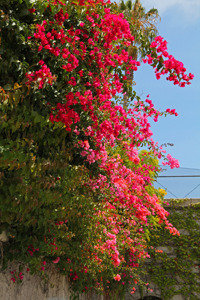 Coming from an area with plenty of rainfall (and humidity) the stark, brown hills dotted with scrub and cacti were a huge change for me as we headed north from Los Angeles to Santa Barbara. The Kentucky definition of 'drought' and the southern California definition are completely different. I was used to seeing grassy fields and lush forests, while this drive definitely required an adjustment in my perception of available moisture.
Coming from an area with plenty of rainfall (and humidity) the stark, brown hills dotted with scrub and cacti were a huge change for me as we headed north from Los Angeles to Santa Barbara. The Kentucky definition of 'drought' and the southern California definition are completely different. I was used to seeing grassy fields and lush forests, while this drive definitely required an adjustment in my perception of available moisture.
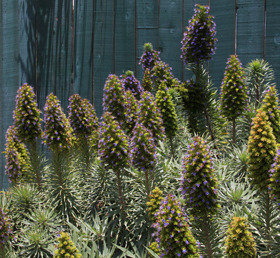 Just when I was starting to pity the poor folks who had to live in this dull environment, flowers started to appear. I was amazed by the huge bougainvilleas and oleanders blooming their heads off in the freeway medians without so much as an extra drop of water! The freeway was a riot of color with these huge shrubs that I'd only experienced as fragile container plants in my area, and here they piled upon each other with abandon as we rolled on up the coast. There were cape honeysuckle and jacarandas with their neon orange and purple blooms splashing here and there and I saw 15 foot tall brugmansias in a few of the yards as we passed. Yes, southern California was experiencing a drought, but with creative use of low-maintenance plants, everything was still beautiful.
Just when I was starting to pity the poor folks who had to live in this dull environment, flowers started to appear. I was amazed by the huge bougainvilleas and oleanders blooming their heads off in the freeway medians without so much as an extra drop of water! The freeway was a riot of color with these huge shrubs that I'd only experienced as fragile container plants in my area, and here they piled upon each other with abandon as we rolled on up the coast. There were cape honeysuckle and jacarandas with their neon orange and purple blooms splashing here and there and I saw 15 foot tall brugmansias in a few of the yards as we passed. Yes, southern California was experiencing a drought, but with creative use of low-maintenance plants, everything was still beautiful.
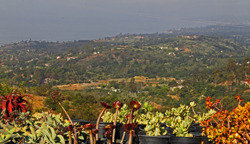 In Santa Barbara, low maintenance succulents and tough plants were used for most of the commercial and residential landscaping we saw. Hostas or ferns weren't seen anywhere. Water (or the lack of it) was something everyone was aware of and signs in public areas reminded folks to keep their water use to a minimum. I was impressed with the landscaping choices that were both beautiful and practical at the same time.
In Santa Barbara, low maintenance succulents and tough plants were used for most of the commercial and residential landscaping we saw. Hostas or ferns weren't seen anywhere. Water (or the lack of it) was something everyone was aware of and signs in public areas reminded folks to keep their water use to a minimum. I was impressed with the landscaping choices that were both beautiful and practical at the same time.
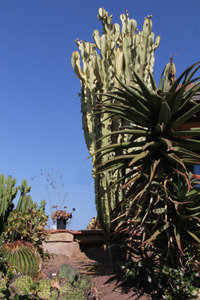 Our Saturday morning was free, so I had previously arranged to visit one of our Garden Watchdog vendors in the area. Trio Nursery is a mail order business, but Kip offered to open up for my visit since I was coming from all the way across the country. His nursery and home are in the hills above the Santa Barbra coast and the view is spectacular. We strolled among his plants and it was so interesting to see the difference in what he offered, from what I was used to seeing. Nurseries in my area may have a small selection of drought-tolerant plants, but here if a plant was a 'water junkie' it didn't make the cut. Beautiful agaves, euphorbias and opuntias along with some tough-as-nails geraniums were the backbone of his offerings and he had enormous specimen plants in his landscaping. Jacarandas, agaves, oleanders and bamboos lined the road up to the top of the mountain, all doing fine without any supplemental water. Humidity was non-existent, especially to someone who feels the air is dry below 70% humidity. We spent the morning comparing notes and taking the full tour which included touching leaves, smelling foliage and tasting herbs. Color and texture were everywhere and I do want to thank Kip and his wife for their gracious hospitality and I came home with some interesting cuttings packed in my suitcase. (They all made it home alive, by the way.)
Our Saturday morning was free, so I had previously arranged to visit one of our Garden Watchdog vendors in the area. Trio Nursery is a mail order business, but Kip offered to open up for my visit since I was coming from all the way across the country. His nursery and home are in the hills above the Santa Barbra coast and the view is spectacular. We strolled among his plants and it was so interesting to see the difference in what he offered, from what I was used to seeing. Nurseries in my area may have a small selection of drought-tolerant plants, but here if a plant was a 'water junkie' it didn't make the cut. Beautiful agaves, euphorbias and opuntias along with some tough-as-nails geraniums were the backbone of his offerings and he had enormous specimen plants in his landscaping. Jacarandas, agaves, oleanders and bamboos lined the road up to the top of the mountain, all doing fine without any supplemental water. Humidity was non-existent, especially to someone who feels the air is dry below 70% humidity. We spent the morning comparing notes and taking the full tour which included touching leaves, smelling foliage and tasting herbs. Color and texture were everywhere and I do want to thank Kip and his wife for their gracious hospitality and I came home with some interesting cuttings packed in my suitcase. (They all made it home alive, by the way.)
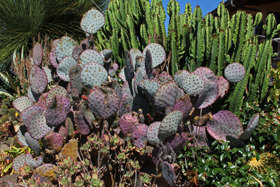 We take water for granted here in my home climate. It regularly falls from the sky, creating vast lakes and reservoirs. We turn the water hose on and mindlessly soak our container plants and gardens, often making plant choices that require obscene amounts of supplemental moisture. Water is cheap and plentiful and compared to our friends in other parts of the world, we waste gallons every day.
We take water for granted here in my home climate. It regularly falls from the sky, creating vast lakes and reservoirs. We turn the water hose on and mindlessly soak our container plants and gardens, often making plant choices that require obscene amounts of supplemental moisture. Water is cheap and plentiful and compared to our friends in other parts of the world, we waste gallons every day.
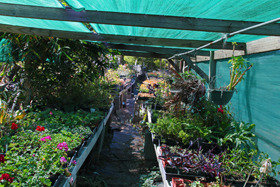 Most of the southern California plants I saw wouldn't survive here for a number of reasons. First and foremost is freezing temperatures. Our west Kentucky winters are considerably colder than theirs and succulent plants tend to rot when the temperatures are cold and damp. The lack of moisture in southern California is a hindrance, but the overabundance of it can be detrimental as well. I was impressed by the educated management of landscaped areas and the use of drought-tolerant plants. It has made me see the need for resource conservation and going forward, I'll try to make more informed plant choices when I'm making purchases in the future.The main thing being, matching the plant to the area. We all have microclimates in our gardens and by embracing these instead of trying to thwart them we can reduce water consumption and the casuality count considerably.
Most of the southern California plants I saw wouldn't survive here for a number of reasons. First and foremost is freezing temperatures. Our west Kentucky winters are considerably colder than theirs and succulent plants tend to rot when the temperatures are cold and damp. The lack of moisture in southern California is a hindrance, but the overabundance of it can be detrimental as well. I was impressed by the educated management of landscaped areas and the use of drought-tolerant plants. It has made me see the need for resource conservation and going forward, I'll try to make more informed plant choices when I'm making purchases in the future.The main thing being, matching the plant to the area. We all have microclimates in our gardens and by embracing these instead of trying to thwart them we can reduce water consumption and the casuality count considerably.
 Our long weekend in California was interesting and fun, and Cassidy graduated with Honors. We enjoyed the change of scenery, climate and hospitality of the area and it was a learning experience that I hope will serve me well in the future. I learned quite a bit about making the most from what you have and that gardeners can create stunning beauty with whatever will grow in their climate. The need for resource conservation was obvious everywhere we went, but so was the natural beauty of the land and and the flora we saw. While the overall look would be out of place in my garden, I can use what I learned to conserve the resources I have and be less wasteful in the future.
Our long weekend in California was interesting and fun, and Cassidy graduated with Honors. We enjoyed the change of scenery, climate and hospitality of the area and it was a learning experience that I hope will serve me well in the future. I learned quite a bit about making the most from what you have and that gardeners can create stunning beauty with whatever will grow in their climate. The need for resource conservation was obvious everywhere we went, but so was the natural beauty of the land and and the flora we saw. While the overall look would be out of place in my garden, I can use what I learned to conserve the resources I have and be less wasteful in the future.
Copyright © www.100flowers.win Botanic Garden All Rights Reserved